Nvidia GeForce GTX 1080 Review - Performance, benchmarks and conclusion Review
Performance, benchmarks and conclusion
Updated: 1080 Ti changes the game, and there's a price drop incoming
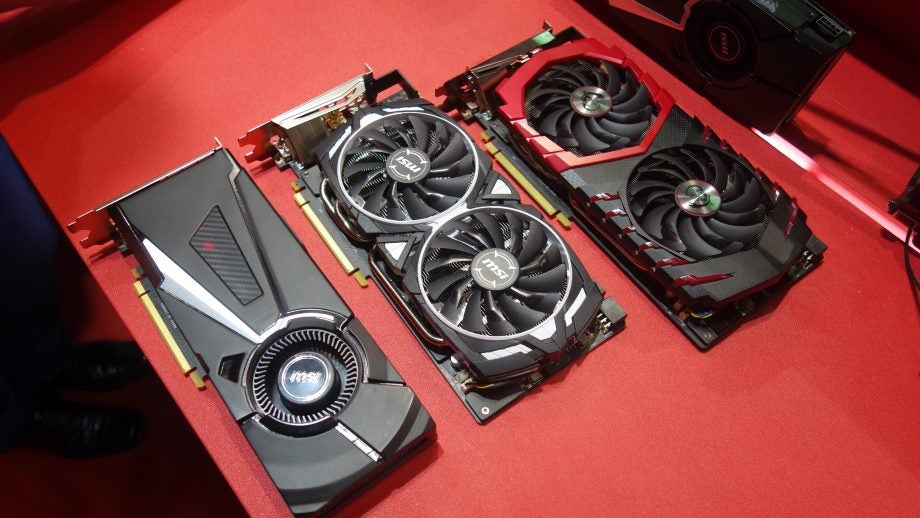
Sections
- Page 1 Nvidia GeForce GTX 1080 Review
- Page 2 Performance, benchmarks and conclusion Review
Nvidia GeForce GTX 1080 – Performance and benchmark results
Testing methodology
Our test bench represents a fairly standard enthusiast gaming PC, with the following components in use.
- Motherboard: Asus Z170-Deluxe
- Processor: Intel Core i5-6600K (not overclocked)
- RAM: Corsair Vengeance 2666MHz, 16GB DDR4
- Cooler: Corsair H60 liquid cooler
- PSU: Corsair CX750M
- SSD: Samsung 850 EVO
- OS: Windows 10 Pro 64-bit
Graphics cards for comparison
For this test, we wanted to get in the two most relevant Nvidia GPUs from the 900-series graphics generation and test them at the same time as the GTX 1080, with the latest drivers available for each.
These are third-party, Non-Nvidia-manufactured components that represent the best of the 900-series generation, just before the 1080 was launched.
- 6GB EVGA GeForce GTX 980Ti
- 4GB MSI GeForce GTX 980 Gaming Edition, provided by Overclockers UK
GTX 1080 versus 980 and 980 Ti – benchmarks
Dirt Rally
Dirt Rally is by far the easiest game to handle here. Its most challenging elements are lighting and fast-moving textures. It’s a great way to test a card’s baseline performance in Full HD and 4K. Its built-in benchmark is fully representative of real gameplay conditions.
In Full HD at Ultra settings, all three cards screamed through the benchmark without any hitches, with the GTX 1080 managing an average of 154.8fps, 10% faster than the 980 Ti and a whopping 40% faster than the GTX 980.
In 4K, all three cards passed with flying colours, but the GTX 1080 was once again a standout performer, managing an average frame rate above the magic 60fps. It was 15% faster than the GTX 980 Ti and 60% faster than the GTX 980, which still managed a decent 39.7fps.
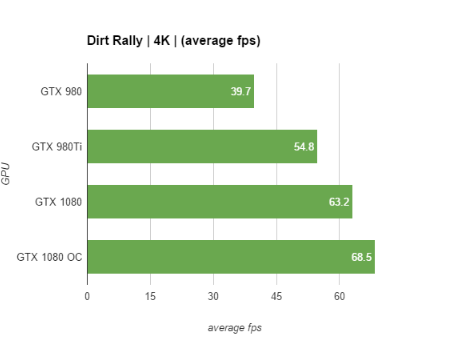
Middle-earth: Shadow of Mordor
Shadow of Mordor is loaded with environmental effects including weather, fire and explosions. Its built-in benchmark is short but packs in all the most challenging effects the game can serve up. I ran the game at maximum graphical settings.
It was here that the GTX 1080 really started to stretch its advantage over its predecessors. While all three passed with flying colours at Full HD, the GTX 1080 delivered an excellent average frame rate of 54.9fps at 4K – 20% faster than the GTX 980 Ti’s 45.9fps and the GTX 980’s 32.7fps. Minimum fps is also important here, and the GTX 1080 never dropped below 42fps during even the most challenging portions of the benchmark.
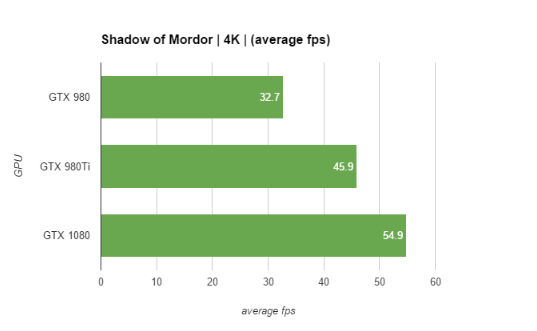
GTA V
GTA V is a technically challenging game with a huge number of things going on at once, challenging both the graphics card and processor of any gaming system. The built-in benchmark tests the game in various ways, and I paid attention to the flying and driving portion, which are by far the most difficult.
I turned every setting up to maximum, with all settings on their highest and all anti-aliasing and visual effects as high as they would go. All three performed commendably at Full HD, but they all struggled a little at 4K.
Even the GTX 1080 could only manage an average 33.3fps, dropping down to 25fps at times. It was 22% faster than the GTX 980 Ti, though, which could only chug to 27.2fps. The GTX 980 wasn’t able to compete in this particular test; GTA V would not allow itself to exceed the 980’s 4GB of memory.
This test was not in any of the GPUs’ favour, so I also ran it with a few of the rather unnecessary effects switched off, and both the 980 Ti and 1080 were considerably more stable while the game still looked great, and both were able to exceed 50fps averages in this instance.
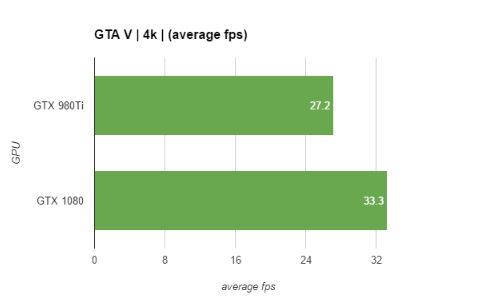
Rise of the Tomb Raider
Rise of the Tomb Raider has some very fancy weather and lighting effects that will tax any GPU. Its built-in benchmark looks at a variety of environments and while it isn’t fully representative of gameplay, it does tax the GPU sufficiently to the point where its results are useful.
At Full HD, all three cards managed decent results, with the GTX 1080 exceeding a 135fps average frame rate – 25% faster than the 980 Ti and 60% faster than the 980.
At 4K resolution, the 980 Ti closed the gap slightly, but the 1080 still led the pack with an average frame rate of 48.3fps – 17% faster than the 980 Ti and 62% faster than the GTX 980.
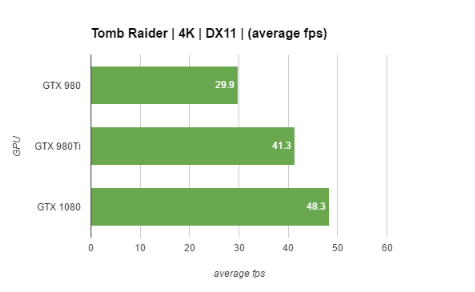
Hitman
Hitman’s built-in benchmark is challenging, with a lot of objects, NPCs and lighting effects. It provides a proper test of both a GPU and CPU.
Hitman proved to be a bit of a head scratcher in Full HD, with the 1080 unable to beat the 980 Ti under any circumstance on our test rig. I suspect there are some bottlenecking issues elsewhere, as this result does not match the results I achieved with any other game. It is worth bearing in mind, though, that as with any new hardware there may be a few ‘ghosts in the machine’ to sort out on your own personal gaming rig before everything runs tickety boo.
At 4K, normal service was resumed, with the GTX 1080 putting in one of its best scores against the 980 Ti. The 1080 managed an average frame rate of 47.7fps, which was 23% faster than the 980 Ti and 65% faster than the 980.
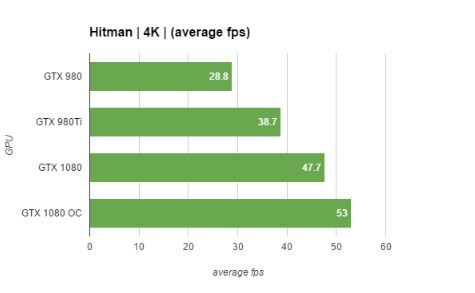
3DMark
I also ran 3DMark’s Fire Strike Ultra benchmark. Fire Strike Ultra isn’t representative of any game in particular, so the scores here only give a partial picture of overall performance and should be taken in the context of all the other results. The GTX 1080 scored a whopping 4,884 – 16% more than the 980 Ti ad 48.6% more than the 980.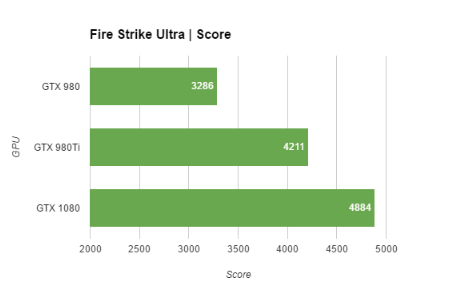
Finally, I ran the Fire Strike Extreme benchmark. This was in order to compare the GTX 1080 with GPUs that weren’t available for this review, such as AMD’s £550-600 R9 Fury X and the Nvidia GeForce Titan X. It’s worth noting the Fury X and Titan X were benchmarked on a different system several months ago, so the results don’t represent anything but a rough comparison of how the GTX 1080 compares, and also doesn’t represent real-world gaming performance.
The GTX 1080 stretched its lead here, well ahead of the Fury X and Titan X.
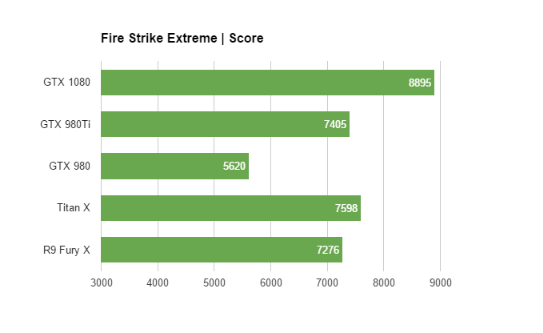
GTX 1080 versus 1070
Our original test results did not include GTX 1070 benchmarks, as that card had not been released.
In most of the benchmarks we ran at 1440p, the GTX 1070 was universally around 15-20% slower than the GTX 1080 at 1440p, with a slightly smaller, but still significant, performance drop at 4K resolutions. Despite the reduction in performance at 1440p, the 1070 is still the best-value choice for today’s games at that resolution; its frame rates in our test titles were well above 60fps in all of our benchmark games.
Bear in mind that third-party versions of each card (we tested the Nvidia-built Founders Edition) have been released, so overclocking and extra cooling will increase both cards’ performance. We’ll be testing them in the near future.
Virtual Reality
The GTX 1080 is clearly cut out for 4K, but VR is where it truly shines. We can’t benchmark in VR, so I’m drawing on my own personal experience to come to conclusions.
First, I fired up the Oculus Rift and Project CARS, a game that has had a fairly rough ride with VR. For a long time, it wasn’t particularly well optimised for virtual reality, but it also provides a huge amount of flexibility for testing GPU performance.
Related: Everything you need to know about virtual reality
The best test I was able to conduct in this game was to head to Donington Park, turn up the graphics to maximum, switch the weather to rain and start from the back of a 38-car grid. On the GTX 980 this was a nauseatingly unpleasant experience, with a huge amount of judder for the entire race.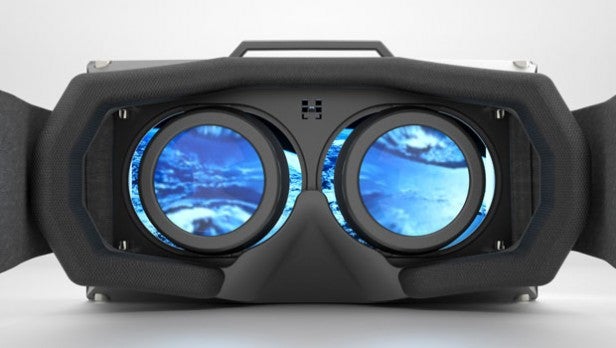
Switching over to the GTX 1080, things were silky smooth with no hint of judder whatsoever. Frame rates seemed to remain at the crucial 90fps where nausea is less likely.
Rinse and repeat for EVE: Valkyrie – the game felt fantastic even with all the settings turned up to max.
Even without all the impressive new VRWorks features enabled, the GTX 1080 is the best choice when it comes to VR games, and things can only get better as developers start plugging some of Nvidia’s features into their titles.
Performance conclusions
The GTX 1080 is much more powerful than the GPUs that came before it, and at 4K resolutions, nothing from the previous generation of Nvidia cards can touch it. It doesn’t quite reach the magic 60fps average at maximum settings for 4K, though, so there is room for improvement. Or, more specifically, room for an inevitable GTX 1080 Ti.
Frankly, though, at 4K resolutions there are plenty of graphical settings you can afford to dial down just a little, and assuming your system doesn’t have any bottlenecks elsewhere, you’ll be averaging 40fps+ on most games in 4K.
I wasn’t able to produce results running compatible games in DirectX 12; there was next to no performance delta when doing so. This is something we’ll revisit when DX12 becomes more widely supported.
Overclocking and SLI
Nvidia is encouraging overclocking with its new GPUs. Its new GPU Boost 3.0 allows more granular changes to frequencies and voltages to improve stability, squeezing the absolute most out of an overclock.
Overclocking on the Founders Edition card was easy and, more importantly, very quiet. I was able to get a fairly meaty 200MHz GPU overclock in around an hour, and I was also able to give the memory a 189MHz clock boost, too, netting some stable 5fps improvements in my standard benchmark games. This bodes extremely well for third-party cooler manufacturers, who will be able to sell cards with beefy coolers and massive overclocks, hopefully without a huge cost premium.
SLI is a tricky issue for the GTX 1080. If you want to run two GTX 1080s together, you can, but go beyond that and you’ll have to register your intentions with Nvidia to get an unlock key to be able to do so. For its part, and I happen to agree, Nvidia SLI beyond two cards these days is a recipe for trouble, because so few games support it properly. Unless you love tinkering and spending too much money, you probably won’t see all that much benefit.
Watch: Your graphics card questions answered – #AskTrusted
Should I buy the Nvidia GeForce GTX 1080?
The GTX 1080 has lived up to its billing in terms of basic performance, which is encouraging when you consider that many of its features can’t even be used yet by the average consumer.
In raw performance terms, it’s a huge step up from the previous-generation GTX 980, although at this point the two are barely comparable due to the huge price and performance gulf.
It’s actually the GTX 980 Ti that presents the biggest problem for a prospective GTX 1080 buyer, especially considering you can find some models for £100 less than the GTX 1080. In many circumstances it’s only 20% slower at Full HD resolutions, and if you’ve no plans to upgrade your monitor to Ultra HD and don’t fancy VR, you’ll be more than happy with its performance for years to come and don’t need to shell out on a GTX 1080.
Or look to the lower-spec and cheaper GTX 1070 if you don’t need top-of-the-range 4K performance.
Verdict
As it stands, it’s the most powerful consumer graphics card you can buy, with AMD yet to show its hand in 2016. The 1080 also represents good value, even if the price is higher than the previous generation. This is (nearly) gaming perfected.


